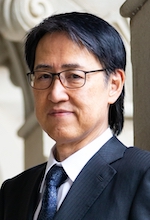UW–Madison researchers lead effort to create a universal coronavirus vaccine
Viruses can be wily adapters, changing their identities to find new hosts and thwart efforts to stop them. That’s why University of Wisconsin–Madison researchers and their collaborators are making progress toward developing universal vaccines against some the planet’s most harmful pathogens, including the virus family responsible for the COVID-19 pandemic.
Last fall, the National Institutes of Health announced it was investing in three teams working to develop a vaccine that would simultaneously work against a broad range of coronaviruses. Among them is a research collaboration, the Pan-Coronavirus Vaccine consortium, led by UW–Madison School of Veterinary Medicine Professor of Pathobiological Sciences Yoshihiro Kawaoka.
“This pan-coronavirus vaccine is basically preparing for the future,” Kawaoka says.
The SARS-CoV-2 virus, which causes COVID-19, belongs to a larger family of coronaviruses that tend to make humans and other animals sick, including Middle East Respiratory Syndrome Coronavirus (MERS) and Severe Acute Respiratory Syndrome Coronavirus (SARS), both of which are also responsible for epidemics. At least four other coronaviruses infect most people by age 10, causing little more than annoying colds.
Since the original strain of SARS-CoV-2 virus first emerged in late 2019, numerous versions of the virus (variants) have also appeared as the virus replicates, and typos in its genetic code equip it with slightly different properties.
Sometimes, these changes have been consequential, and — as happened with the delta and omicron variants — have become what public health officials call variants of concern. As these variants emerge, experts rush to study whether they will still respond to the countermeasures developed to combat them, including vaccines.
The project led by Kawaoka and his collaborators, totaling about $7 million in funding from the National Institute of Allergy and Infectious Diseases, is looking for a vaccine or vaccines that could train our immune systems to respond to a broader array of coronaviruses, including SARS-CoV-2, and their variants.
Before 2019, no one had ever seen SARS-CoV-2. If successful, a pan-coronavirus vaccine would also protect against other as-yet-unknown coronaviruses.
Vaccines tend to rely on features of a pathogen that are most likely to help the body’s immune system both identify it and also mount a response, preventing or limiting illness. Most vaccines are relatively specific to the pathogen they target.
The COVID-19 vaccines now authorized or approved by the Food and Drug Administration in the U.S., and by the World Health Organization globally, have proven effective at protecting people from severe illness and death from SARS-CoV-2, even as variants and waning immunity have rendered the vaccines less effective at preventing initial infection.
If successful, a pan-coronavirus vaccine would also protect against other as-yet-unknown coronaviruses.
“The pan-coronavirus vaccine may not be as effective as a vaccine that is specific for a particular strain, like SARS-CoV-2,” says Kawaoka, but the trade-off for reduced effectiveness is increased coverage.
Adds Peter Halfmann, research associate professor in the Kawaoka lab at the Influenza Research Institute, it would mean “having something ready to go in case something did pop up.”
For instance, if the world already had a pan-coronavirus vaccine in March 2020, it could have served as a mitigation tool until vaccines specific to SARS-CoV-2 could be developed.
“Ideally, though,” Kawaoka says, “a pan-coronavirus vaccine that is as effective as a specific vaccine would be nice.”
And that’s what the researchers seek to do. In particular, the consortium is searching for regions of the viral spike protein (a unique feature that gives coronaviruses their name) that are most likely to be shared between members of the coronavirus family.
Once identified, the scientists will test how well these portions of the protein stimulate the immune systems of mice to generate an antibody response, and compare this to data from independent, complementary studies of human immune reactions.
Members of the collaboration will then select those proteins, or antigens, that perform well and use them to vaccinate mice and hamsters (a good model because they develop illness similar to humans), studying how well the vaccines protect the animals when they are exposed to coronaviruses in the lab.
If the world already had a pan-coronavirus vaccine in March 2020, it could have served as a mitigation tool until vaccines specific to SARS-CoV-2 could be developed.
The researchers will also take the high-performing antigens and attach them to a nanoparticle that mimics a whole virus. Kawaoka’s lab had already been testing this platform, developed by Ravi Kane at Georgia Tech University, and their own platform as part of efforts to develop a universal influenza vaccine. They found that Kane’s nanoparticle was more effective at presenting the antigen to the immune system, creating a better response.
“It displays the antigen a lot better than just the protein by itself; it gives you much better protection,” says Halfmann, noting that the prior experiences between the two labs made the approach possible, and that preliminary data shows it might also work for coronaviruses. “It fully protected hamsters against the original (SARS-CoV-2) virus we were using.”
The researchers will also study how long vaccine-induced immunity lasts and whether vaccination can prevent transmission between animals.
In addition to Georgia Tech’s Kane, other major collaborators on the project include Patrick Wilson at Weill Cornell Medicine and Paul Thomas of St. Jude Children’s Research Hospital.
The NIH is also funding work centered at Brigham and Women’s Hospital and at Duke University, each focusing on different approaches to developing broad-based vaccines, including in vulnerable populations, and expanding understanding of immune responses to vaccines specific to age and sex. The agency announced it would be issuing additional funding to more institutions in 2022.
Kawaoka expects vaccine candidates they identify now are at least five years away from the clinic, but his lab and others will continue to invest the time, energy and resources to solving these challenges.
The future may depend on it.





